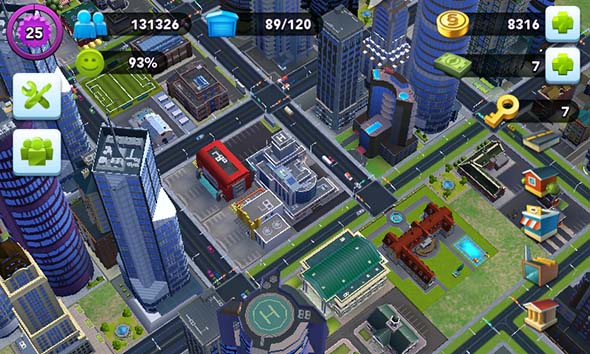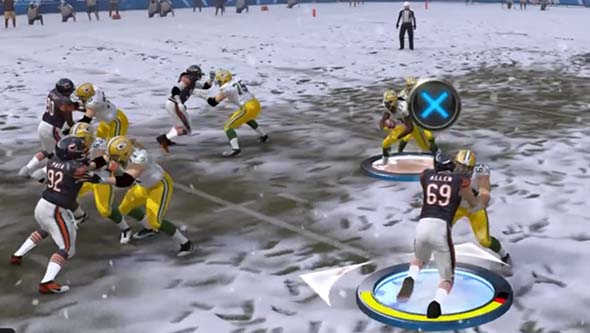A friend of mine introduced me to the social game SimCity Buildit, currently available for mobile devices and tablets. Since I currently lack a strong mainstream entry in the SimCity franchise, I thought I'd see if this social game does anything to fill my long-neglected need for spline-reticulation or if it presented any new features that could be worth pursuing in a full PC version of the game. I don't generally play social games. I dabbled a bit with CivWorld and Sims Social, but that's about it. So I lack a lot of reference for judging SimCity Buildit in terms of other social games.

Most of the fundamental SimCity elements are here: you set housing, commercial, and industrial zones, link them with roads, and build service buildings in order to satisfy various citizen needs within a certain radius. None of the deeper simulation elements of newer city-builder games are there. Individual citizens don't exist; there's just an abstract population, and happiness levels are set for each residential building. It's understandable for the limitations of the platform, and it provides a retro quality that reminds me of the good ol' days of SimCity 4.
But since this is a social game, the design has to put up numerous barriers to restrict the player's freedom to construct the city that they want. You have to "level up" your city by building new buildings. The number of residences that you can build, as well as the availability of industry and shops are also limited by your level or by the city population.
You also don't really have an economy to manage - at least not in the traditional sense. Citizens don't work at factories and shops. Instead, these buildings create certain building materials that are used to "upgrade" your residences into higher-density buildings that generate more tax revenue. This provides the core challenge of the game: you have to build the necessary materials in order to upgrade your buildings. Each of these materials take different amounts of real time to construct in your factories and shops (or you can buy the materials you need through real-money micro-transactions). As you level up, you'll unlock new materials, which residences will suddenly demand in order to upgrade their buildings.

You don't have to manage employment, tax rates, or city ordinances; only resources and service coverage.
The ability to upgrade a building seems to be limited by its happiness level. Only happy residences can be upgraded, so you also need to provide city services such as power, water, waste disposal, emergency services, entertainment, and so on. But these services are very frustrating because they are tied to your city level. New services or entertainments become unlocked when you level up. That's fine. But once those services are unlocked, your entire city starts demanding them, and happiness plummets (as well as tax income, which is tied to happiness) because you don't already have the infrastructure ... [More]
Be the first to rate this post - Currently .0/5 Stars.
- 1
- 2
- 3
- 4
- 5
Tags:SimCity, SimCity Buildit, Electronic Arts, EA, Track Twenty, online, social gaming, mobile, mobile gaming, Facebook, Google Play, city simulation, public service, disaster, industry, supply

Regular readers of my blog who happen to be football fans may have noticed that I never reviewed last year's EA Sports football games. I had played and reviewed the games every year for the previous three years, but not last year. The truth is: I didn't play last year's games. There were a few reasons for this.
For one, I was kind of burnt out on football games, and was neck deep in RPGs like Skyrim and Dark Souls, as well as Brave New World and some modding. So my plate was rather full. I was somewhat curious about the next-gen football games being released on the PS4 and XBox One, but I had neither system, so couldn't play them. And I wasn't really sure that the PS3 version would be worth playing, since EA's focus was probably (and hopefully) on improving the next-gen games. I didn't want to waste my time on an inferior version of the game that may have been "incomplete" compared to its next-gen counterpart. So I skipped last year's football games entirely.
I still don't own a PS4 or XBox One, and don't have any immediate plans to buy either. But a friend granted me the use of his PS4 so that I could try the P.T. demo. I figured while I have the PS4, might as well try the new Madden, so I picked up a used copy on eBay fairly cheap.
Since I was borrowing a friend's PS4, my time with the game was limited. As such, this review can't be as in-depth as some of my previous football game reviews have been.
EA is continuing to make small, iterative changes to the game's mechanics, as well as recycling mechanics and features from earlier iterations of the game. This year's focus was on defensive control and line of scrimmage play, both of which are areas that were in desperate need of an overhaul. Unfortunately, EA's changes were mostly superficial.

"New" defensive controls are just prompts for commands that already existed. At least they work better now...
The game advertises new defensive controls for breaking blocks and tackling. The only thing that is really "new" is the ability to steer blockers in order to fill gaps or maintain containment. This helps to give defensive linemen a greater sense of presence, as they aren't run out of the play by blockers quite so easily, and gap control is actually possible.
The other new defensive controls are really just fluff features... [More]
4.5 [2 rating(s)] - Currently 4.5/5 Stars.
- 1
- 2
- 3
- 4
- 5
Tags:Madden NFL 15, Madden NFL, EA, EA Sports, Tiburon, sports, football, NFL, simulation, Infinity Engine, NCAA Football, ultimate team, connected careers, franchise, highlight, PS4
This review was originally published 01/21/2011 on Game Observer (now defunct as of 05/13/2014). It has been republished here for archival purposes.
Across-the-board interface improvements and incredible new Pro Mode make this the definitive music-rhythm game!
This review is a bit belated. This is mostly due to the fact that I didn’t want to write a full analysis of the game until I had a chance to play the new PRO guitar mode, the controls for which weren’t available publicly until late December. So if you’re still on the fence about purchasing this game even though it’s been out since October, I hope this review helps.

Three new controllers for PRO Mode (top to bottom):
Fender Mustang controller (available late November 2010) has 102 buttons to simulate the lower 17 frets.
Fender Stratocaster Midi guitar (available spring 2011) is a console-agnostic, fully-functioning, 6-stringed guitar equipped with pressure sensors in the neck for finger-placement detection.
MadCatz Keytar (available at game release, but sold separately) is a two-octave midi keyboard that can be used to play keys, guitar, or bass parts of songs.
Analysts and sales numbers may be suggesting that the music-rhythm genre is dying, but Harmonix isn’t letting that stop them from trying to innovate. Rock Band 3 is a very ambitious project that adds a whole new instrument (the keyboard) and attempts to incorporate REAL INSTRUMENTS into the gameplay. I am thrilled to say that both of these new marquee features work excellently!

The game’s menus and interface have also been streamlined to include more filters for selecting songs and new menu widgets for each player that they can open and close anytime they want to change settings, drop in or out, customize their characters, and so forth. Speaking of character customization, you now have much more options for creating your characters’ faces by mixing, matching, and editing different parts of the face (similar to the customization options allowed in The Sims).
I bet you all want to know about how the new PRO Mode feature works, so I won’t waste anymore time, and I’ll dive right into this ground-breaking new feature: [More]
Be the first to rate this post - Currently .0/5 Stars.
- 1
- 2
- 3
- 4
- 5
Tags:Rock Band 3, review, Rock Band, PRO Mode, Electronic Arts, EA, Harmonix, MTV Games, music, music-rhythm, PS3, Wii, XBox 360

For those of you paying attention, EA's launch of SimCity was a disaster. Server problems combined with the always-online DRM requirement prevented many gamers from even being able to play the game, while others had to wait hours just to connect, more suffered crashes and glitches, and still others lost save files (and hours of progress) due to failures in specific servers that housed their game files.
It got so bad, online retailer Amazon.com pulled the game from its site, citing the unplayable state of the servers. They've since reinstated the game, but with a warning to consumers, and a lowly 1 1/2-star rating (as of the time of this writing).
Having participated in one of the closed Betas for the game, I was fully aware of the potential for problems, since Beta users were plagued by server issues that prevented many players from even being able to login to test the game. I had to wait hours before the server was operational long enough for me to load a city, and even then, I got booted off several times. It was incredibly frustrating, especially with the knowledge that the Beta would only last through the weekend, so I was under pressure to login as quickly as possible and spend as much time as possible with the game before the Beta ended.

One of the best features of the game is the snap-to-grid for building roads that lets you keep your roads nice and parallel, even if they curve!
So I fully anticipated server problems with the launch, since I didn't trust EA to put any real effort into making sure the game would work. This is the same EA that won a consumerist award for the "Worst Company in America" in 2012! And deservedly so! Despite the servers not being up to par during the two closed Betas, EA still seemed to think the online infrastructure was suited for a full retail launch. Boy were they wrong! [More]
5.0 [2 rating(s)] - Currently 5.0/5 Stars.
- 1
- 2
- 3
- 4
- 5
Tags:SimCity, SimCity 5, city simulation, Maxis, EA, Electronic Arts, DRM, Digital Rights Management, always online, server, EA Origin, closed beta, beta, CitiesXL, Will Wright
This review was originally published 09/14/2010 on Game Observer (now defunct as of 05/13/2014). It has been republished here for archival purposes.

More than just a roster-update, but Gameflow is worthless and not worth the full price if you already own Madden 10.
It’s that time of year again. It’s time for the annual release of EA’s powerhouse licensed NFL game, Madden. This year’s release promises to completely redefine the way people play football games by bringing the playbooks of hundreds of plays down to one pre-selected play based on a Gameplan. It’s the way NFL coaches really do it, and once you stop and think about it, the idea really is brilliant. But a good game needs more than just good ideas. The ideas need to work. And Gameplanning just simply doesn’t.
I’ve always played the Madden games for the strategy and coaching elements. So when I first heard that the game would now be picking my plays for me, I was skeptical and afraid. But after hearing the arguments, and thinking about it a little bit, the change actually did make sense and even had me excited.
The Madden developers were claiming that gamers would be able to Gameplan for their upcoming opponent by setting up which plays to run in any given situation -- exactly how real NFL coaches do it. The system also had the potential to make full-length, 15-minute-quarter games more playable and practical, since the combination of the Accelerated Clock and GameFlow means that all the time spent between plays is now simulated. A default-length game of 7-minute quarters takes half an hour. And a full-length 15-minute-quarter game can be completed in less than an hour. An in-game save would have also helped make full-length games more practical for those of us who still may not have a full hour to devote for one continuous game. But too bad, we didn’t get that. [More]
Be the first to rate this post - Currently .0/5 Stars.
- 1
- 2
- 3
- 4
- 5
Tags:Madden NFL 11, review, Madden NFL, NCAA Football 11, EA, EA Sports, Tiburon, sports, football, simulation, GameFlow, PC, PS2, PS3, Wii, PSP, XBox 360
|

| 12 | | | | | | | 60 | | 11 | | | | | | | 55 | | 10 | | | | | | | 50 | | 09 | | | | | | | 45 | | 08 | | | | | | | 40 | | 07 | | | | | | | 35 | | 06 | | | | | | | 30 | | 05 | | | | | | | 25 | | 04 | | | | | | | 20 | | 03 | | | | | | | 15 | | 02 | | | | | | | 10 | | 01 | | | | | | | 05 |
|